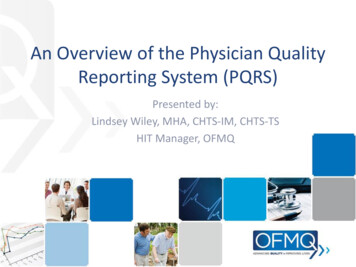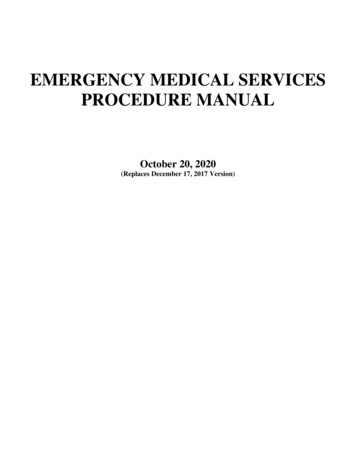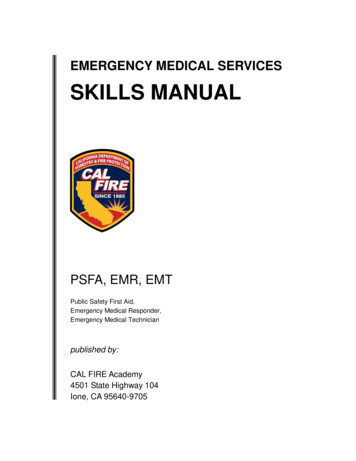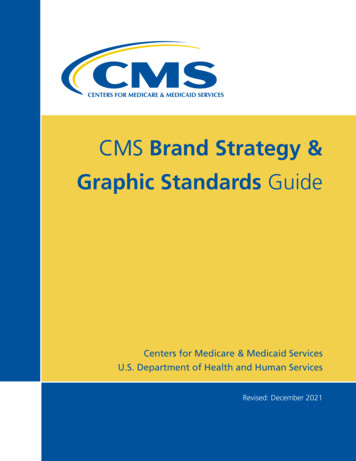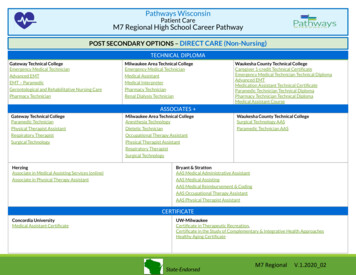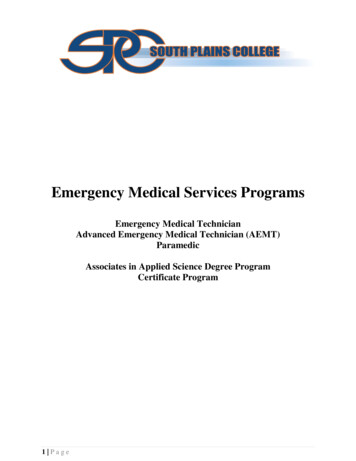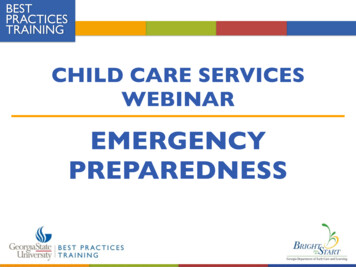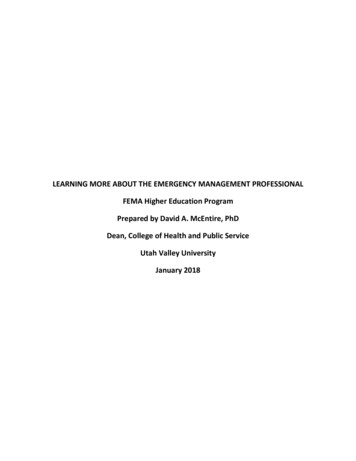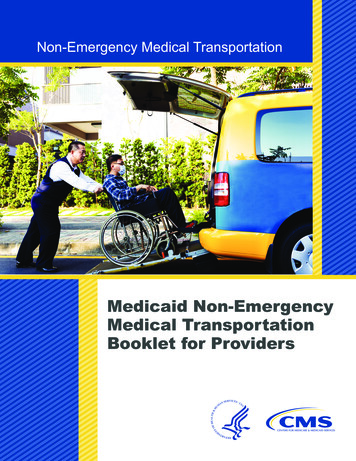
Transcription
Non-Emergency Medical TransportationMedicaid Non-EmergencyMedical TransportationBooklet for Providers
Content SummaryMedicaid non-emergency medical transportation (NEMT) is an important benefitfor beneficiaries who need to get to and from medical services but have no means oftransportation. The Code of Federal Regulations requires States to ensure that eligible,qualified Medicaid beneficiaries have NEMT to take them to and from providers.However, every State’s Medicaid program is different. In addition, each State has theoption of developing and implementing Medicaid waiver programs, which can providecoverage for additional transportation needs. Waiver program rules can also vary fromState to State and even within the same State’s programs. Providers are responsible forknowing and abiding by the specific rules for each State where they furnish services,and for each of the programs for which they furnish services. The booklet cites Statespecific examples to illustrate the rule discussed.This booklet summarizes the general scope of Medicaid-covered emergencytransportation and NEMT benefits and reviews principles applicable to such coverage.It also explains three modes for States to provide or arrange for covered NEMT,common Medicaid transportation fraud and abuse issues, and provider tips to helpprevent fraud and abuse. In addition, the booklet encourages providers to regularlycheck that their employees and contractors are not excluded from Federal healthcare programs.Medicaid Non-Emergency Medical Transportation Booklet for Providers2
Qualifying for Medicaid Non-EmergencyMedical TransportationThe Code of Federal Regulations (CFR) requires States to “specify that the Medicaidagency will ensure necessary transportation for beneficiaries to and from providers;”and “describe the methods that the agency will use to meet this requirement.”[1] Forsituations that do not involve an immediate threat to the life or health of an individual,this requirement is usually called “non-emergency medical transportation,” or NEMT.For this booklet, an eligible beneficiary is defined as “an individual who has beendetermined eligible and is currently receiving Medicaid.”[2] For most individuals, theseeligibility determinations are based on means-testing, by comparing an individual’sincome and, for some individuals, assets against an income or resource standard.Individuals with income or resources below the standard are determined eligible.Means-testing is an objective way to determine whether someone meets the criteria forMedicaid benefits.When beneficiaries are eligible for Medicaid benefits, they may or may not qualifyfor NEMT services. To qualify, States may require that there be an unmet transportationneed.[3, 4] Depending on State law, a qualifying unmet need can include: Not having a valid driver’s license;Not having a working vehicle available in the household;Being unable to travel or wait for services alone; orHaving a physical, cognitive, mental, or developmental limitation.[5]Emergency and Non-EmergencyMedical Transportation DefinedAn emergency is any event that puts the health and life of a Medicaid beneficiary atserious risk without immediate treatment. Real emergencies occur when the medicalneeds of a beneficiary are immediate and due to severe symptoms. A life-threateningevent such as uncontrolled bleeding, heart attack, an automobile accident, or otherserious trauma may cause the symptoms.[6] Medicaid reimburses emergencytransportation providers when they furnish services to eligible beneficiaries accordingto the rules.The Medicaid NEMT benefit is authorized under the Social Security Act section1902(a)(70) and 42 CFR section 440.170. Medicaid NEMT is transportation for eligibleMedicaid beneficiaries to and from appointments and services for those who have aMedicaid Non-Emergency Medical Transportation Booklet for Providers3
legitimate need for the services.[7, 8] At a minimum, a State Medicaid agency (SMA)or its designated managed care entity must: Ensure necessary transportation to and from providers;Use the most appropriate form of transportation;[9] andInclude coverage for transportation and related travel expenses necessary tosecure medical examinations and treatment.[10]As an NEMT provider, be sure to know the specificMedicaid rules for NEMT and any general State licensingor certification requirements for vehicles and drivers in theStates where you furnish services, as they can be differentfrom State to State. Most States publish a providertransportation manual. If you have questions or concerns,call the SMA for assistance.Links to each SMA website, where specific questions andconcerns can be answered, may be found at tion/By-State/By-State.html on the Medicaidwebsite. States are invested in making sure that services are appropriate and furnishedin accordance with Medicaid rules, that beneficiary needs are met, and that providersare paid correctly.Contract AgreementStates can manage the authorization of NEMT coverage or contract with anotherentity to manage NEMT coverage, such as a transportation broker or a managed careorganization.[11] Regardless of who manages NEMT coverage, Medicaid rules requirethe transportation provider to have a contract with the appropriate entity before anyservices are furnished.[12] If the provider is not under contract, Medicaid paymentwill not be available even if all of the other requirements for NEMT have been met.Prior AuthorizationOnce a provider has a contract agreement, many States require coverage oftransportation services to be preauthorized before the beneficiaries receive transportation.States preauthorize transportation in a variety of ways. For example, one State mayexpect a physician to authorize the need for beneficiary transportation, another Statemay only want to know that the beneficiary’s location drop-off was to a medicalappointment, while a third State may expect the medical facility to phone in themedical transportation request before providing services.[13] Each State establishesits own preauthorization rules.Medicaid Non-Emergency Medical Transportation Booklet for Providers4
Loaded MileageState Medicaid payment rules may take into account loaded mileage, location, andwait times. States and contracted transportation entities may only pay fee-for-servicetransportation providers for loaded mileage (a managed care entity may be paid a permember per month fee [pmpm]). A typical SMA definition of loaded mileage is thetime a beneficiary is actually in the vehicle.[14] If a driver arrives at a preauthorizeddestination for pickup and transport and the beneficiary does not show up for theappointment, then that person is a no-show, and the provider generally cannot bill forthe trip. Claiming loaded mileage when the beneficiary was a no-show is a commonform of fraud in NEMT, and is an illegal practice.[15] It is called “billing for servicesnot rendered” and may be prosecuted under the False Claims Act.LocationState Medicaid rules may require beneficiaries to be picked up at home and taken totheir medical services, and then be dropped off at home after they receive services. Ifa trip is to a nonmedical destination like the grocery store, shopping mall, to meet afriend, or something similar, State Medicaid rules do not cover the trip. Do not bill thetrip to the Medicaid agency.[16]Wait TimesFinally, providers need to know that in most States, they cannot receive additionalpayment based on wait times. The costs of wait times may have been taken into accountin determining overhead costs in setting transportation payment rates. Check with theState or the managing entity for any mandatory wait times in your State.[17]Types of TransportationThe different types of vehicles that providers can use for beneficiary transport to andfrom covered medical services include wheelchair vans, taxis, stretcher cars, and buses.In addition, providers can use other transportation determined appropriate bythe SMA. For example, other transportation options might include air transportation oran ambulette.[18]Transportation ServiceDelivery SystemsThere are different types of systems States can use to ensure non-emergencytransportation for eligible Medicaid beneficiaries. This booklet discusses three of thosesystems. The three systems are: a transportation broker, transportation as a managedcare benefit, and non-preauthorized contractors or vendors.Medicaid Non-Emergency Medical Transportation Booklet for Providers5
Transportation BrokerA Medicaid transportation broker contracts with an SMAto manage preauthorized NEMT services in a designatedarea. The broker bids for the opportunity to managethese services. The potential brokers submit bids, andthe SMA evaluates them and choses brokers based ontheir “experience, performance, references, resources,qualifications, and costs.”[19] States hold nongovernmentalbrokers accountable to their contracts and the State Medicaidrules through regular audits and monitoring.Once a broker has obtained an NEMT contract, they must “ensure that transportpersonnel are licensed, qualified, competent, and courteous.”[20] This is true for anyMedicaid provider that hires drivers, not just brokers.Not all States use brokers to ensure NEMT services. Some States retain theresponsibility for qualifying and authorizing beneficiaries for transportation and thencontract with one or more entities to furnish the transportation services.Transportation as a Managed Care BenefitStates may contract with a managed care plan (MCP) that is then responsible forbeneficiary transportation. The MCP must meet requirements for network sufficiency,solvency, and all other managed care requirements.Non-Preauthorized Contractor or VendorStates can also contract with independent transportation providers. These transportationproviders must be qualified to provide the transportation under applicable State law.These transportation providers may include public transit options (buses, subway),professional drivers (taxis, limousines, vans), or volunteer drivers (family, friends,State-approved volunteers).Driver CriteriaDepending on the State, there may be special criteria drivers must meet before theytransport Medicaid beneficiaries. First, they must have the appropriate, current licensesfor the types of vehicles they drive when transporting others. For example, States mayrequire a chauffeur’s license (or equivalent) for taxis and vans.Second, a State may have qualifications for drivers that exceed the minimum toensure that Medicaid beneficiaries receive a high quality of transportation. Standardsmight include limiting the number of points drivers can have against their license,[21]Medicaid Non-Emergency Medical Transportation Booklet for Providers6
certifying the health of a driver,[22] carrying vehicle liability insurance,[23] or havinga criminal background check.[24] A recent OIG report found that some NEMT providersin one State had not completed the required online criminal background check.[25]Drivers should be required to treat beneficiaries with courtesy and respect. TheState, the broker, or the transportation company should monitor any complaints madeby beneficiaries related to access and quality—including any complaints received aboutthe driver’s behavior—and hold drivers accountable. In several States, two of the morefrequent complaints about transportation providers concern the timeliness of the driverand the driver not showing up. Other top complaints include problems with the driver’sbehavior and “other stakeholders.”[26, 27, 28]Vehicle CriteriaIt is important for transportation providers to remember that there may also be specificvehicle documentation and maintenance requirements.[29, 30] States may, for example,require providers to have documented proof the vehicle belongs to the correct entityand the identification number matches the ownership papers; the vehicle is legallylicensed; the vehicle license plate is on the correct vehicle; and the vehicle is in goodcondition, safe for transport, and receives regular maintenance.[31] In addition, theState may require proof the vehicle has the current State-required liability insurance.Fraud and Abuse DefinedMost transportation providers are honest and want to do the right thing. For example,a recent OIG report on California NEMT services outside of Los Angeles County foundthat 89 percent of sampled claims were compliant.[32] On the other hand, there areproviders billing fraudulent, wasteful, or abusive claims. A provider must return anypayment it receives for an improper claim to the SMA. Properly billing claims is theresponsibility of everyone involved with Medicaid services. Brokers, providers, anddrivers are all accountable for following Medicaid rules. Failure to comply withMedicaid transportation rules can result in penalties, fines, and prosecution, aspreviously discussed. Take the time to learn the definitions of fraud and abuse,understand common transportation schemes, and learn tips for preventing fraudand abuse. Check to ensure Federal health care programs do not exclude employeesand contractors.Medicaid rules define fraud as “an intentional deception or misrepresentation madeby a person with the knowledge that the deception could result in some unauthorizedbenefit to himself or some other person.”[33] Fraudulent practices include billing formileage when a beneficiary is not in the vehicle and billing for services that werenever furnished.Medicaid Non-Emergency Medical Transportation Booklet for Providers7
Abuse is different from fraud. The Medicaid rules define abuse as practices“inconsistent with sound fiscal, business, or medical practices, and result in anunnecessary cost to the Medicaid program, or in reimbursement for services thatare not medically necessary or that fail to meet professionally recognized standardsfor health care.”[34]Fraud Schemes and ResultsAny person or group of persons committing fraudulentacts can be held accountable. Fraudulent acts can include avariety of simple or elaborate schemes, as illustrated by thefollowing examples.Independent Contractor—ParentSome States reimburse parents, considered independentcontractors, for the cost of medically necessary trips. Forexample, a woman in Idaho was State-approved to regularlytransport her child from their home in Idaho Falls, Idaho, to Salt Lake City for necessarymedical treatment. However, in late 2007 through 2010, she began billing for trips thatnever occurred.The State Attorney General’s Medicaid Fraud Control Unit (MFCU) filed criminalcharges against her. She was charged with three counts of Medicaid provider fraudand one count of grand theft. She pleaded guilty to two Medicaid fraud charges forfalsifying her medical trip records and for receiving payment for the claims billed.On June 4, 2012, she was sentenced to jail. In addition to jail time and 5 years ofprobation, she was ordered to pay fines, restitution, and investigative costs of roughly 21,500.[35]Beneficiary FraudA beneficiary who transported himself to dialysis treatments pleaded guilty toconspiring with an ambulance company owner to allow him to bill Medicaid forambulance transportation for his dialysis appointments. The beneficiary even signedambulance run sheets and transported other patients to dialysis in his own vehiclewhile the ambulance company owner billed for ambulance transportation for thosepeople as well. The beneficiary also received kickbacks for referring other patients tothe ambulance service.[36]Company Owner: Services Not RenderedProviders should only bill for services rendered. If a beneficiary fails to show for atransportation appointment, a provider cannot bill Medicaid for the no-show. Nor shouldMedicaid Non-Emergency Medical Transportation Booklet for Providers8
providers misuse beneficiary information to claim services they never provided.The owner of an Indiana NEMT company was found guilty of billing for services neverprovided, including billing for cancelled trips, upcoding some trips, and using patients’medical identifiers without their knowledge to bill for services they never received.The fraud scheme resulted in a loss of over 1 million to Indiana Medicaid.[37]Providers must use the most cost-effective mode of transportation when transportingMedicaid beneficiaries. They normally use ambulettes for transporting beneficiarieswith a disability or for those who are convalescing and need additional care. Beneficiarieswho use a wheelchair may be transported by ambulette. It is cost prohibitive to useambulettes for those who do not need them. In May 2015, the owner of an ambulancecompany was sentenced to 6 months in jail and ordered to repay 200,000 to Medicaid.For 4 years, the owner had modified transportation request forms for a taxi to make itappear the patients needed the more expensive ambulette transportation.Company—Qualified DriversDrivers must be qualified to transport Medicaid beneficiaries. Otherwise, the servicesare ineligible for reimbursement. On May 1, 2012, a Wisconsin specialized medicalvehicle transportation company was convicted of falsifying drivers’ records. Thecompany documented that its drivers were trained and certified to furnish the servicesrendered to Medicaid beneficiaries. Former employees testified that the documentationwas false.The company was convicted of 18 counts of medical assistance fraud and ordered topay a 10,000 fine and court costs.[38]Company Owner—Unauthorized VehiclesVehicles must be qualified when transporting Medicaid beneficiaries. A New Yorkambulette company owner was sentenced to 6 months in jail and 5 years’ probationfor modifying NEMT authorizations for taxi rides to ambulette services, which were 4times more expensive. In addition to his sentencing, he also made full restitution of the 200,000 he stole from Medicaid.[39, 40]Taxi DriverBeneficiaries who qualify for transportation services may only use the services formedically necessary appointments. Providers may not be reimbursed for services, evenif they are furnished, if the services do not meet Medicaid rules (for example, droppingbeneficiaries off at the grocery store or at a friend’s home).On December 18, 2012, a taxi driver in Alaska was convicted for violating Medicaidrules by taking beneficiaries to locations other than medical appointments, purchasingMedicaid Non-Emergency Medical Transportation Booklet for Providers9
unused vouchers from investigators, and submittingvouchers for reimbursement that did not reflect the actualservices he furnished.The Anchorage driver was convicted of committing medicalassistance fraud and ordered to pay a 500 fine and restitution.He was also sentenced to 3 years of probation and received alifetime ban from billing for Medicaid-furnished services.[41] This action is called termination from a State Medicaidprogram. Providers who are excluded from one State’sMedicaid program must also, by law, be excluded from all States’ Medicaid programsas well as from Medicare programs nationwide.Fraud and Abuse Prevention TipsPreventing Medicaid transportation fraud is the responsibility of all providers.Providers should, within the scope of their authority and job duties, document theinformation the State wants, document furnished services completely and accurately,verify services were furnished according to the documentation, and bill correctly.For example, brokers, company owners, and drivers each have documentationresponsibilities and should be sure their documentation is complete and accurate. Onlybrokers and owners have responsibility for verifying services were furnished accordingto what was documented.Tip 1: Document Completely and Accurately,and Maintain RecordsThe Social Security Act requires all Medicaid providers to keep records and furnishthem to the State upon request.[42] Each State determines what must be documented,and providers are responsible for keeping the information and producing it if theState asks for it. Transportation brokers and companies typically have their owndocumentation requirements in addition to what the State wants. To make sure theydocument records accordingly, providers will want to develop and implement specifictransportation policies and procedures and see that their drivers are fully trained tomeet the expectations.Policies and procedures should emphasize the importance of drivers documentingrecords accurately and completely and include disciplinary action, up to and includingtermination, for falsifying transportation records. The main goals of documentation areto submit claims that represent the services furnished and to justify the claims billed.To meet these goals, records should be accurate and complete.Medicaid Non-Emergency Medical Transportation Booklet for Providers10
At a minimum, all States require providers to document the beneficiary’s name andMedicaid identifier, the pickup and drop-off locations, the date and time the serviceswere furnished, and the number of miles traveled with the beneficiary in the vehicle.Drivers should only document the number of loaded miles, as discussed previously.Although there is no Federal rule requiring it, some States require transportationrecords to be in ink instead of pencil.[43] Some providers furnish drivers with printedcomputer sheets and allow them to document information directly on the sheets. If youdo this, include this process in your policy, so if audited, the auditor understands whythere is written information on the computer-generated documents.[44]Remember, if a service is not documented, there is no point in submitting a claim forreimbursement.Tip 2: Verify ServicesSome States and brokers require drivers to obtain the beneficiary’s signature onthe transport record at the end of the trip.[45] Even if the beneficiary’s signature isrequired, it is the responsibility of management or a designee to verify documentedservices were furnished according to the record.[46] Do this by making random callsto beneficiaries listed on the record, and to personnel at the medical appointmentlocation verifying beneficiary arrival and services.Tip 3: Bill AccuratelyOnce services are verified, they can be billed. The claims submitted must reflect theactual services furnished. Providers normally bill State transportation services on theCenters for Medicare & Medicaid Services Form-1500 (CMS-1500). Instructions forthe CMS-1500 include the following NOTICE: “Any person who knowingly filesa statement of claim containing any misrepresentation of any false, incomplete ormisleading information may be guilty of a criminal act punishable under law and maybe subject to civil penalties,”[47] so be sure to code claims correctly and represent theservices furnished. Be sure to teach drivers not to embellish their records. This is fortheir own well-being.CMS offers guidelines for claims submission: Use an original red-ink-on-white-paper CMS-1500 claim form;Use dark ink on the form;Use lift-off correction tape if making corrections to the form;Avoid handwritten, printed, or stamped information on the form;Make sure there are no staples, clips, or tape on the claim form;Remove any perforated edges on the claim form; andInclude any required documentation with the claim form.[48]Medicaid Non-Emergency Medical Transportation Booklet for Providers11
Check for Excluded Individuals and PartiesProviders should take one final action to protect themselves and their businesses fromimproper billings. Providers need to have a policy and procedure in place to check forexcluded individuals and parties. As part of doing business,providers should make it part of policy and procedure to bediligent in screening all employees and contractors beforehiring or contracting with them, and repeat the checksmonthly to determine whether they are excluded fromparticipation in Federal health care programs.[49, 50]The U.S. Department of Health and Human Services,Office of Inspector General (HHS-OIG) has the authorityto exclude individuals and entities from participating inFederal programs for various reasons. Reasons include beingconvicted of certain crimes, losing one’s license for lack of professional competenceor financial integrity, or engaging in conduct prohibited by Medicaid rules.[51] WhenHHS-OIG excludes individuals or entities from participation, it places their names onthe List of Excluded Individuals and Entities (LEIE).[52] In the past, providers werealso encouraged to check the Excluded Parties List System (EPLS). This has beenreplaced by the Exclusions Extract on the System for Award Management (SAM).SAM combines the Federal procurement systems and the Catalog of Federal DomesticAssistance into one new system and includes the functionality of the Central ContractorRegistry (CCR), Federal Agency Registration (Fedreg), Online Representations andCertifications Application, and the Exclusions Extract. SAM is a Federal governmentsite intended to streamline information for providers.[53]It is important to note that an HHS-OIG exclusion does not technically prohibitindividuals or entities from participating in Federal programs, but it does prohibit themfrom receiving Federal payment for items or services they furnished. “Furnished” is akey word—it refers to items or services provided directly or indirectly by an excludedindividual or entity.[54]According to HHS-OIG, “The effect of an OIG exclusion is that no Federal healthcare program payment may be made for any items or services furnished (1) by anexcluded person or (2) at the medical direction or on the prescription of an excludedperson.”[55] All claims furnished or submitted by an excluded individual or entitymay be considered overpayments subject to recoupment. In addition, the transportationentity may be liable for civil monetary penalties and possible exclusion from Medicaidand other Federal health care program participation. Almost anyone can face exclusion.CMS has issued guidance to SMAs stating that they should require providers toscreen their employees and contractors for exclusions by checking the LEIE databaseon a monthly basis. The guidance further advises States to require all providers toMedicaid Non-Emergency Medical Transportation Booklet for Providers12
immediately report any exclusion information discovered. States can find the guidancein State Medicaid Director Letter Number 09-001.[56] Providers should check theSAM Exclusions Extract as well.To prevent hiring excluded individuals or entities, implement a process for exclusionscreening. It is the business owner’s responsibility to make sure they do not employeeor contract with excluded individuals. Check for excluded individuals by visiting theLEIE at https://oig.hhs.gov/exclusions/index.asp on the HHS-OIG website and SAMExclusions Extract at https://www.sam.gov/portal/SAM/#1 on the SAM website. Visithttps://oig.hhs.gov/exclusions/tips.asp for quick tips on how to use the HHS-OIGwebsite. The Exclusions FAQ (frequently asked questions) section on the HHS-OIGwebsite has additional information.[57]Report Fraud and AbuseReport suspected fraud or abuse! Most States do a preliminary investigation anddetermine whether to send the case to the MFCU. Some States may have regulatorylanguage requiring reporting simultaneously to the SMA and MFCU. Check with yourSMA for reporting procedures and document any cases reported to the SMA or MFCU. SMA and t fraud and suspected fraud.htmlHHS-OIGATTN: HotlineP.O. Box 23489Washington, DC 20026Phone: 1-800-447-8477 (1-800-HHS-TIPS)TTY: 1-800-377-4950Fax: 1-800-223-8164Email: HHSTips@oig.hhs.govWebsite: sionFraud and abuse carry consequences for perpetrators. Penalties depend on the act andthe intent. Those found guilty might have to repay Medicaid funds and pay fines andpenalties; might be excluded from Federal programs; or might face probation, housearrest, or prison. Medicaid fraud and abuse are serious offenses; be part of the solution.Medicaid NEMT is an important and necessary service for beneficiaries who do nothave the means to get to and from their medical appointments. Everyone associatedwith Medicaid transportation must play their part to stop fraud and abuse. Be awareMedicaid Non-Emergency Medical Transportation Booklet for Providers13
of the rules pertaining to each State Medicaid program where services are furnished.Be sure to document furnished services and that the documentation is accurate andcomplete by verifying services occurred as recorded. Then bill them correctly andbe sure there are no excluded individuals or entities on staff. Following the rules ofMedicaid and these tips will protect the Medicaid transportation program along withthe provider, the provider’s employees, and the beneficiaries.To see the electronic version of this booklet and the other products included in the“Non-Emergency Medical Transportation” Toolkit, visit the Medicaid ProgramIntegrity Education page at ic-landing.html on theCMS website.Follow us on Twitter#MedicaidIntegrityReferences1 Assurance of Transportation, 42 C.F.R. § 431.53. Retrieved March 15, 2016, from http://www.ecfr.gov/cgibin/retrieveECFR?gp &SID 0c7ee7a5cbe463eda67e0e61810a8627&mc true&n pt42.4.431&r PART&ty HTML#se42.4.431 1532 Definitions and Use of Terms, 42 C.F.R. § 435.4. Beneficiary. Retrieved March 15, 2016, from http://www.ecfr.gov/cgi-bin/text-idx?SID f3a933445ef67278bd2f009091b1703a&mc true&node se42.4.435 14&rgn div83 Social Security Act § 1902(a)(30)(A). Retrieved March 15, 2016, from https://www.ssa.gov/OP Home/ssact/title19/1902.htm4 Sufficiency of Amount, Duration, and Scope, 42 C.F.R. § 440.230. Retrieved March 15, 2016, f
Medicaid Non-Emergency Medical Transportation Booklet for Providers. 3. Qualifying for Medicaid Non-Emergency Medical Transportation. The Code of Federal Regulations (CFR) requires States to "specify that the Medicaid
